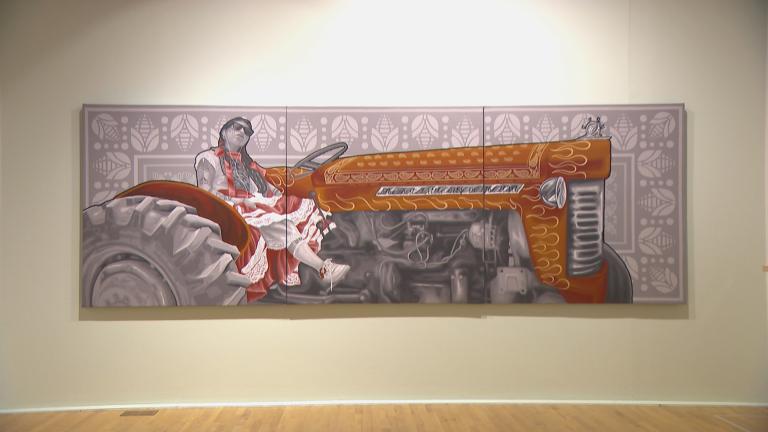Video: Joining “Chicago Tonight: Latino Voices” is Cesáreo Moreno, director of visual arts and chief curator at the National Museum of Mexican Art. (Produced by Joanna Hernandez)
A fierce woman, carved in stone, clutches a human head by the hair. She’s a player in “the ballgame,” the brutal, sacred sport tied to rituals of early Mesoamerica.
Talk about “the winner takes it all.”
Femme fatales and goddesses play for keeps at a new exhibit at the National Museum of Mexican Art. These deities and grande dames — etched in rock or molded from clay — are visiting Pilsen from their home turf near the Gulf Coast of Mexico.
The exhibition “Ancient Huasteca Women: Goddesses, Warriors and Governors” offers a glimpse of women in the Mesoamerican civilization known as the Huasteca (wăs-Te-kah), including their influential roles within the culture.
Recently unearthed treasures, buried for a thousand years or more, are part of this visiting exhibition from the Instituto Nacional de Antropología e Historia in Mexico City.
One focal point is the sculpture and story of “The Young Woman of Amajac,” a major archeological discovery found by a farmer in the state of Veracruz in 2021. The young ruler dons a flowing headdress, and she wears a sphinxlike expression on her face. Is it wonder? Is it woe? Either way, fatefully resurrected, she’s now in a museum on 19th Street in Chicago, far from her tropical home.
 “The Young Woman of Amajac,” a major archeological discovery found by a farmer in 2021 is on display at the National Museum of Mexican Art. (Marc Vitali / WTTW News)
“The Young Woman of Amajac,” a major archeological discovery found by a farmer in 2021 is on display at the National Museum of Mexican Art. (Marc Vitali / WTTW News)
Among the nearly 100 artifacts are jaguar fangs in necklaces and fertility figures in the form of plump pottery vessels. Female representations shed light on the social strata of the early cultures and their rituals and symbols, including body scarification — which was reserved for the elite.
The highlights are the dozen life-size stone sculptures of women of influence, earthly and celestial. They are the handiwork of lapidaries — stone craftsmen — from millennia ago. It’s believed there was a quarry or masonry workshop in the area, now likely buried under centuries of vegetation.
The Huasteca region runs along the Gulf of Mexico near the present-day Mexican states of Veracruz, Hidalgo, Tamaulipas, Querétaro and San Luis Potosi. The exhibition covers the geography and also a vast expanse of time, from 1500 BC to 1400 CE — nearly 30 centuries before the Spanish arrival in Mexico — but it mostly focuses on the Late Classic and Postclassic periods, roughly 1,500 years ago.
It’s a mind-expanding look at a long-lost tropical civilization where elite women held some authority in the pre-Hispanic era. The cryptic figures fire the imagination with history and mystery — what we know and what we don’t — about an ancient indigenous people of Mesoamerica.
“Ancient Huasteca Women: Goddesses, Warriors and Governors” runs through July 21 at the National Museum of Mexican Art, 1852 W. 19th St.
Note: This article was published May 3, 2024, and updated with video May 16, 2024.
 “Ancient Huasteca Women: Goddesses, Warriors and Governors” runs through July 21 at the National Museum of Mexican Art. (Marc Vitali / WTTW News)
“Ancient Huasteca Women: Goddesses, Warriors and Governors” runs through July 21 at the National Museum of Mexican Art. (Marc Vitali / WTTW News)








